On a freezing, cloudless January morning, a woman stood in front of the Tomb of the Unknown Soldier in Ottawa and handed out small photos of Nazzareno Tassone from a Ziploc bag.It was a headshot of him, wearing camouflage fatigues against a bright yellow background with a red star that said YPG — the acronym for the Kurdish People’s Protection Units. Eventually, the image was pinned on the jackets of everyone who had come to pay tribute to the 24-year-old Edmonton man who died fighting the Islamic State alongside Kurdish forces in Syria. He’s become one of the dozens of Westerners who have died fighting with the Kurds.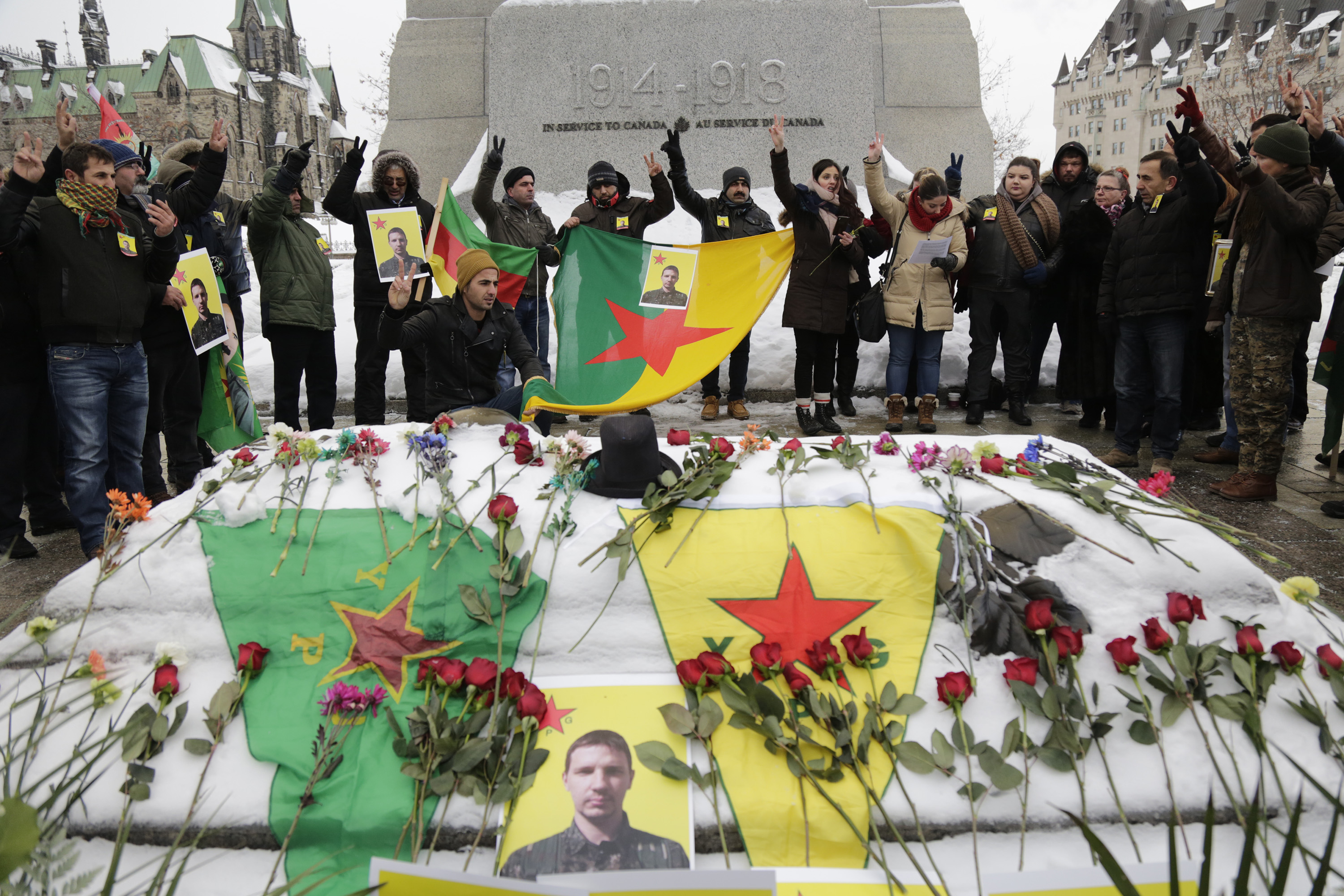 Even though IS militants are still holding his body for payment, Kurdish community members and other YPG fighters from across Canada didn’t wait to honour their fallen comrade. There is no official program or rules to follow for a ceremony like this, the first of its kind in this country. Unlike the elaborate rituals for men and women who lose their lives fighting for the Canadian Armed Forces, no one was in charge. Still, the mourners who had gathered on Monday moved with purpose and said they felt like Tassone’s spirit was among them.Several men, and one woman, in fatigues walked into the crowd, they were instantly recognized as some of those Canadians who have volunteered, like Tassone, and lived to tell the tale. They’re spread out across the country, and this was the first time they all met in person. Often looked down upon by the government and military as little more than a ragtag group of thrillseekers with a death wish, here they were treated like heroes.
Even though IS militants are still holding his body for payment, Kurdish community members and other YPG fighters from across Canada didn’t wait to honour their fallen comrade. There is no official program or rules to follow for a ceremony like this, the first of its kind in this country. Unlike the elaborate rituals for men and women who lose their lives fighting for the Canadian Armed Forces, no one was in charge. Still, the mourners who had gathered on Monday moved with purpose and said they felt like Tassone’s spirit was among them.Several men, and one woman, in fatigues walked into the crowd, they were instantly recognized as some of those Canadians who have volunteered, like Tassone, and lived to tell the tale. They’re spread out across the country, and this was the first time they all met in person. Often looked down upon by the government and military as little more than a ragtag group of thrillseekers with a death wish, here they were treated like heroes.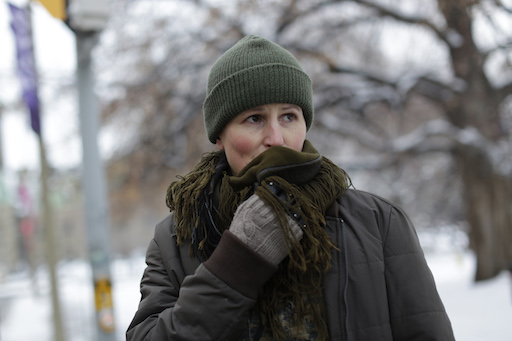 A Kurdish man gave his jacket to Hanna Bohman, a former model from Vancouver who returned from fighting with the women’s defence unit known as the YPJ in Jun 2016, and who sports a Canadian flag badge on her sleeve. Others whispered and pointed to Kiril Drago, known by his Kurdish nom de guerre Gabar Tolhildan, a Quebecer who returned home in September after nine months fighting with the YPG. Strangers threw their arms around them and accosted them for selfies.Someone blasted a Kurdish anthem on a cell phone as a circle formed around Tassone’s mother and siblings, who made a last minute decision to drive from Niagara Falls for the ceremony.It’s the same place where Corporal Nathan Cirillo was shot and killed while guarding the tomb two years ago by a gunman who supported the Islamic State. Like Tassone, Cirillo was killed at 24.“This is the perfect spot to remember Nazzareno Tassone as a real victim of terrorism, even if we’re the only ones who do so and our government won’t,” said Gabar.Fighting with the YPG isn’t criminal, but it’s highly discouraged, by the government. Invitations for the ceremony sent to politicians and the army either went unanswered or elicited a boilerplate media statement.
A Kurdish man gave his jacket to Hanna Bohman, a former model from Vancouver who returned from fighting with the women’s defence unit known as the YPJ in Jun 2016, and who sports a Canadian flag badge on her sleeve. Others whispered and pointed to Kiril Drago, known by his Kurdish nom de guerre Gabar Tolhildan, a Quebecer who returned home in September after nine months fighting with the YPG. Strangers threw their arms around them and accosted them for selfies.Someone blasted a Kurdish anthem on a cell phone as a circle formed around Tassone’s mother and siblings, who made a last minute decision to drive from Niagara Falls for the ceremony.It’s the same place where Corporal Nathan Cirillo was shot and killed while guarding the tomb two years ago by a gunman who supported the Islamic State. Like Tassone, Cirillo was killed at 24.“This is the perfect spot to remember Nazzareno Tassone as a real victim of terrorism, even if we’re the only ones who do so and our government won’t,” said Gabar.Fighting with the YPG isn’t criminal, but it’s highly discouraged, by the government. Invitations for the ceremony sent to politicians and the army either went unanswered or elicited a boilerplate media statement. As is the case with many Westerners who take up arms for the Kurds, Tassone had no military experience or familial connection to the Middle East and didn’t tell many people where he was going. Even after he arrived at the military base on his own dime, training was limited at best. He loved to role-play with nerf guns at home, and was a fierce critic of IS, but no one expected he would take it this far.Public safety officials have repeatedly tried to dissuade any Canadians from joining the YPG’s efforts — which receives financial backing from the US — with warnings of physical danger and vague threats that participating in any activities that “facilitates” terrorism abroad might be charged with a crime when they get home. Those who have participated range from a 67-year-old ESL teacher to a 19-year-old woman from Edmonton. The Turkish ambassador to Canada recently called for the government to make more of an effort to halt its citizens from joining the group.While some fighters get questioned at airports and border crossings due to the Iraqi stamps in their passports, they say the guards just want to know more about what it was like over there and give them words of encouragement. No Canadian has been charged for fighting with the YPG or the YPJ.“It is in the battle of Raqqa that Sehid Agir Ararat [Tassone’s martyr name] closed his eyes for the final time but left behind hope, revolution, equality, and freedom,” one young Kurdish woman from Montreal told the crowd in a prepared speech at the ceremony that had swelled to over 100. “We believe that martyr Nazzareno is part of our family, and we will forever be proud of him. We want his family to know that they are our family now.”After several rounds of chanting Tassone’s martyr name and a moment of silence, the fighters regroup and are desperate to get out of the cold — most wearing only a scarf or vest on top of the camouflage. An older Kurdish man insists on taking them all to Tim Hortons for coffee. He emigrated from Turkey to Canada 25 years ago and wanted to be called John for fear of reprisals by Turkey. In Turkey’s view, the YPG is an offshoot of the the Kurdistan Workers’ Party, the PKK, which both Turkey and Canada have deemed a terrorist entity. John says he isn’t involved with the YPG directly, but stays in touch with Canadian fighters, and footed the bill for Bohman’s flight from Vancouver. “She couldn’t afford it and I knew in my heart she had to be here,” he said.
As is the case with many Westerners who take up arms for the Kurds, Tassone had no military experience or familial connection to the Middle East and didn’t tell many people where he was going. Even after he arrived at the military base on his own dime, training was limited at best. He loved to role-play with nerf guns at home, and was a fierce critic of IS, but no one expected he would take it this far.Public safety officials have repeatedly tried to dissuade any Canadians from joining the YPG’s efforts — which receives financial backing from the US — with warnings of physical danger and vague threats that participating in any activities that “facilitates” terrorism abroad might be charged with a crime when they get home. Those who have participated range from a 67-year-old ESL teacher to a 19-year-old woman from Edmonton. The Turkish ambassador to Canada recently called for the government to make more of an effort to halt its citizens from joining the group.While some fighters get questioned at airports and border crossings due to the Iraqi stamps in their passports, they say the guards just want to know more about what it was like over there and give them words of encouragement. No Canadian has been charged for fighting with the YPG or the YPJ.“It is in the battle of Raqqa that Sehid Agir Ararat [Tassone’s martyr name] closed his eyes for the final time but left behind hope, revolution, equality, and freedom,” one young Kurdish woman from Montreal told the crowd in a prepared speech at the ceremony that had swelled to over 100. “We believe that martyr Nazzareno is part of our family, and we will forever be proud of him. We want his family to know that they are our family now.”After several rounds of chanting Tassone’s martyr name and a moment of silence, the fighters regroup and are desperate to get out of the cold — most wearing only a scarf or vest on top of the camouflage. An older Kurdish man insists on taking them all to Tim Hortons for coffee. He emigrated from Turkey to Canada 25 years ago and wanted to be called John for fear of reprisals by Turkey. In Turkey’s view, the YPG is an offshoot of the the Kurdistan Workers’ Party, the PKK, which both Turkey and Canada have deemed a terrorist entity. John says he isn’t involved with the YPG directly, but stays in touch with Canadian fighters, and footed the bill for Bohman’s flight from Vancouver. “She couldn’t afford it and I knew in my heart she had to be here,” he said.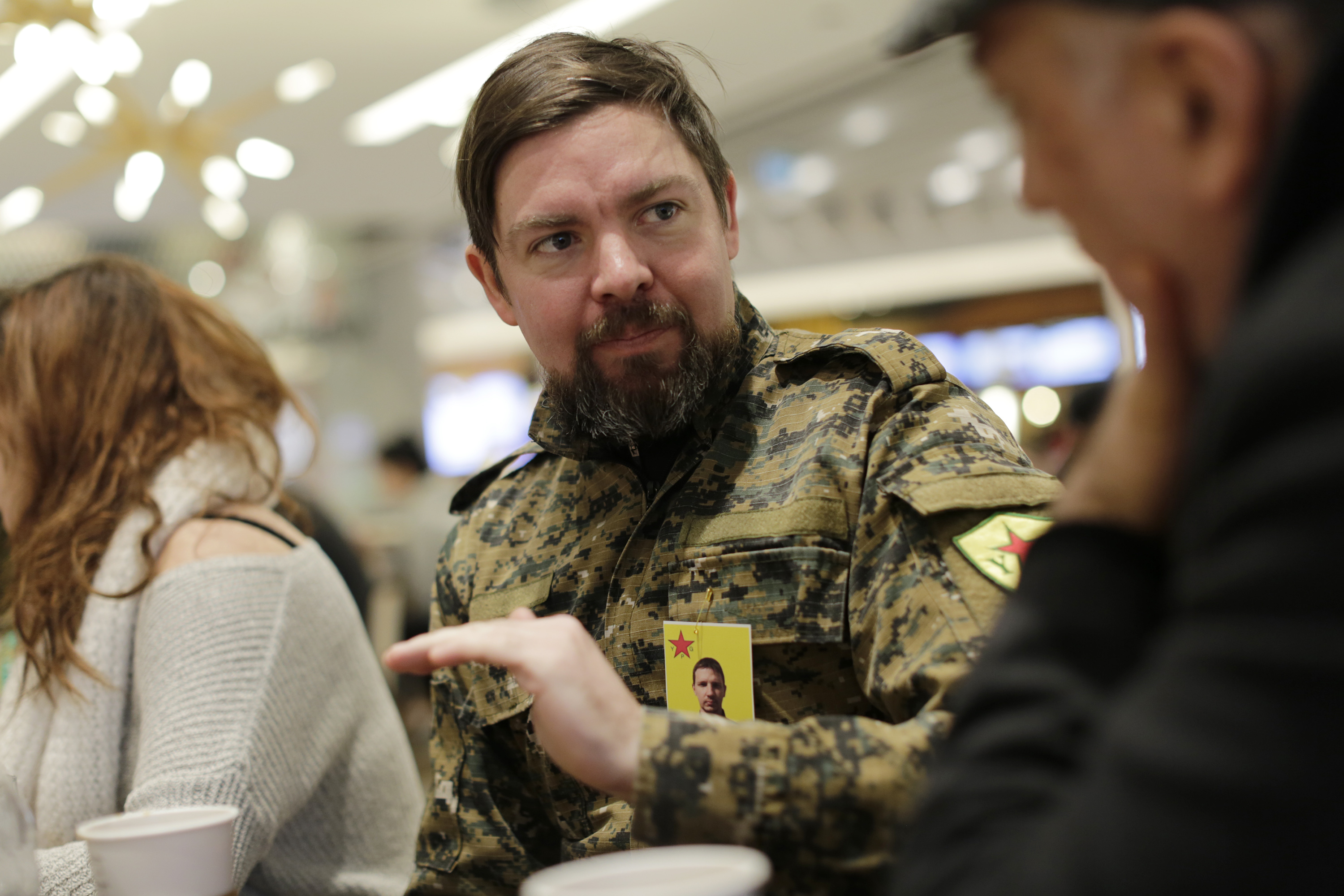 **“I want to make you understand why we do what we do.”Hozan Kobani, now living in Montreal, was seated in the coffee shop, as loud conversations in English, French, and Kurdish rose around him.“It’s complicated because we’re operating in the greyest legal area, and you never know how the opinions of the those in charge might shift,” said the 35-year-old who fought with the YPG for six months until last June. “The whole ceremony today is like the way the war is being done. It’s mostly Kurdish people just figuring it out themselves and doing whatever they can. In one sense, it’s organic, on the other side, you see the war and the deaths that are caused by a lack of real support.”Kobani immersed himself in Kurdish politics and the freedom movement after abandoning the lengthy process of joining the Canadian army reserves, and rejecting Prime Minister Justin Trudeau’s decision to pull out from the airstrike mission against IS. But it was really the words of John Gallagher — the other Canadian and former member of the armed forces who died while fighting with the militia in 2015 — that cemented his decision to go.Kobani was heavily involved with anti-fascist and anarchist groups as a student in English and political science at the University of Toronto and later came across Gallagher’s paper criticizing leftist politics. Gallagher left his master’s program at York University for what he described as the pacifism of the left, and continued to lay into those who espoused that ideology.“He shook my beliefs when he wrote that the left wing movement in Toronto and the West wasn’t calling IS what it is, which is fascism. In my opinion, many leftist activists I know wanted to kind of sweep it under the rug, because it made them uncomfortable that it was fascism not coming from a European source, mostly by non-white people,” he said. “It didn’t fit in with their identity politics and it wasn’t politically correct.There’s a genocide against Kurdish people, and it’s hypocritical for the left to be silent about it.”
**“I want to make you understand why we do what we do.”Hozan Kobani, now living in Montreal, was seated in the coffee shop, as loud conversations in English, French, and Kurdish rose around him.“It’s complicated because we’re operating in the greyest legal area, and you never know how the opinions of the those in charge might shift,” said the 35-year-old who fought with the YPG for six months until last June. “The whole ceremony today is like the way the war is being done. It’s mostly Kurdish people just figuring it out themselves and doing whatever they can. In one sense, it’s organic, on the other side, you see the war and the deaths that are caused by a lack of real support.”Kobani immersed himself in Kurdish politics and the freedom movement after abandoning the lengthy process of joining the Canadian army reserves, and rejecting Prime Minister Justin Trudeau’s decision to pull out from the airstrike mission against IS. But it was really the words of John Gallagher — the other Canadian and former member of the armed forces who died while fighting with the militia in 2015 — that cemented his decision to go.Kobani was heavily involved with anti-fascist and anarchist groups as a student in English and political science at the University of Toronto and later came across Gallagher’s paper criticizing leftist politics. Gallagher left his master’s program at York University for what he described as the pacifism of the left, and continued to lay into those who espoused that ideology.“He shook my beliefs when he wrote that the left wing movement in Toronto and the West wasn’t calling IS what it is, which is fascism. In my opinion, many leftist activists I know wanted to kind of sweep it under the rug, because it made them uncomfortable that it was fascism not coming from a European source, mostly by non-white people,” he said. “It didn’t fit in with their identity politics and it wasn’t politically correct.There’s a genocide against Kurdish people, and it’s hypocritical for the left to be silent about it.”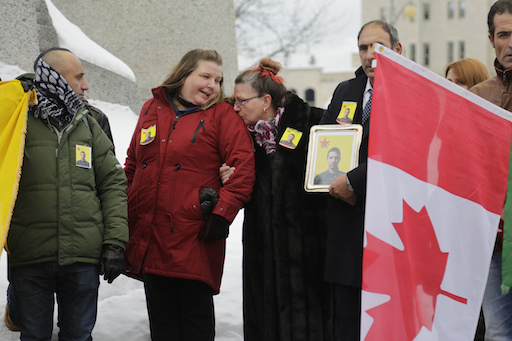 A couple of Kurdish guys interrupted to take a video of Kobani to send to their YPG contacts back in Syria. “They want to see what you’re doing now!” one said in broken English waving his iPhone in his face. There’s an endless amount of videos they share with each other over social media, sometimes the only way for them to communicate when they don’t speak the same language.The screening process for YPG recruitment doesn’t include much more than making sure you’re not a fascist, said Kobani, and that you believe in democracy and equal rights for women. “And after a week of hanging around the base, me and two other European guys were put on the first front line to attack a city between Raqqa and Mosul — both IS strongholds at the time,” he recalled. The rumour, he said, is that IS militants can get paid hundreds of thousands of dollars for the dead body of a Western fighter they capture.“They basically told me we we’re in Daesh [a derogatory term for IS] land now and we were very likely going to die.I smoked a lot of cigarettes and then we snuck through the mountains in a convoy … They blasted Kurdish war music to keep us motivated.”On the horizon, he saw a truck carrying IS militants on a suicide mission. YPG fighters with the “sabotage unit” had previously moved around the landmines laid by IS so that the militants wouldn’t know where they were. “They took the truck out, and I was thrilled, but now they knew we were there.” Kobani and his fellow fighters took turns waiting for reprisals and eventually saw that a civilian family in a nearby village had been severely injured as a result of another bomb explosion from a different truck.“Up until this point, it was awesome, but then I thought ‘what am I doing?’ And in subsequent missions I lost my German friend, who became a role model.” Though he was successful overall in his efforts, he was going into severe debt and had to return home. “I would go back in a heartbeat, but at some point you have to decide what life you want.”
A couple of Kurdish guys interrupted to take a video of Kobani to send to their YPG contacts back in Syria. “They want to see what you’re doing now!” one said in broken English waving his iPhone in his face. There’s an endless amount of videos they share with each other over social media, sometimes the only way for them to communicate when they don’t speak the same language.The screening process for YPG recruitment doesn’t include much more than making sure you’re not a fascist, said Kobani, and that you believe in democracy and equal rights for women. “And after a week of hanging around the base, me and two other European guys were put on the first front line to attack a city between Raqqa and Mosul — both IS strongholds at the time,” he recalled. The rumour, he said, is that IS militants can get paid hundreds of thousands of dollars for the dead body of a Western fighter they capture.“They basically told me we we’re in Daesh [a derogatory term for IS] land now and we were very likely going to die.I smoked a lot of cigarettes and then we snuck through the mountains in a convoy … They blasted Kurdish war music to keep us motivated.”On the horizon, he saw a truck carrying IS militants on a suicide mission. YPG fighters with the “sabotage unit” had previously moved around the landmines laid by IS so that the militants wouldn’t know where they were. “They took the truck out, and I was thrilled, but now they knew we were there.” Kobani and his fellow fighters took turns waiting for reprisals and eventually saw that a civilian family in a nearby village had been severely injured as a result of another bomb explosion from a different truck.“Up until this point, it was awesome, but then I thought ‘what am I doing?’ And in subsequent missions I lost my German friend, who became a role model.” Though he was successful overall in his efforts, he was going into severe debt and had to return home. “I would go back in a heartbeat, but at some point you have to decide what life you want.”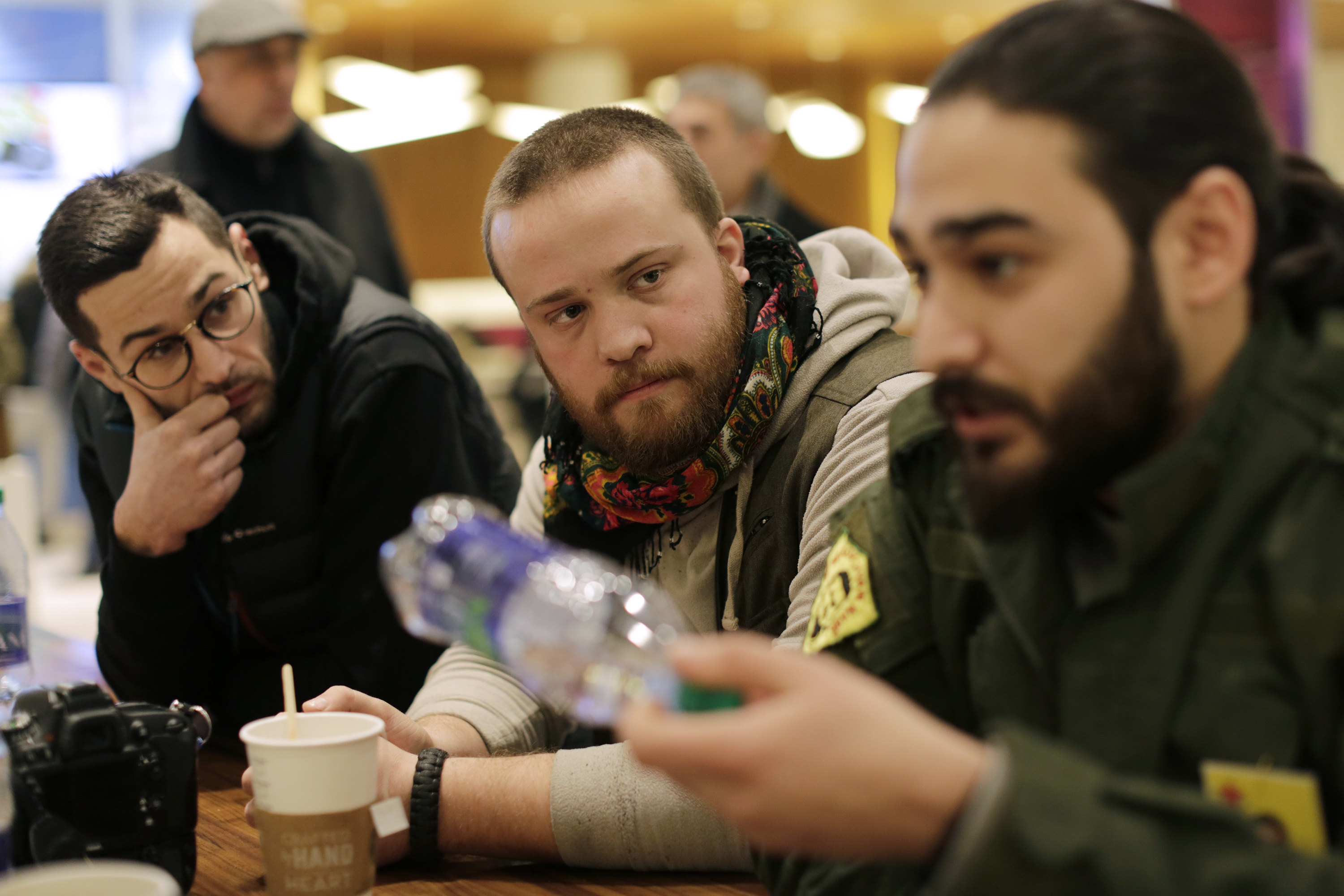 **John the Kurdish man said it was time to move on. He wanted to treat everyone to lunch at Jimmy the Greek in the food court of the Rideau Center shopping mall.“There’s no point in even trying to refuse,” laughs Hanna Bohman. “The culture of hospitality is so strong and we’re like celebrities.” Bohman is one of three known Canadian women who have joined the YPJ. The youngest is Shaelynn Jabs, a 19-year-old Edmonton girl who’s gone back and forth twice to fight with the militia, despite a lack of any military training and the blast of suicide truck near her unit that left her deaf in one ear and fractured her skull.“They’re waiting for me to eat before they start,” Bohman, now 48 years old, says before taking a bite of her shawarma meat. Since returning home in the summer of 2015, she says her life feels empty. She was compelled to join the group after watching a video of Ottawa-born John Maguire, a Muslim convert who was recruited by IS and eventually killed in Syria, imploring others to carry out lone wolf terror attacks.“I thought if Canadians can just join IS, there must be a way for us to join the fight, for real, on the other side.” After discussions with a YPJ recruiter, she went over, and had even less training than Kobani — just four hours. “They saw me shoot on the range, and I’m a very good shooter because my family hunted in the Prairies, so they made me a sniper.”“During one offensive, IS almost shot my head off because I was the tallest out of all the shorter Kurdish girls. There was only six of us out there. I wasn’t nervous to die, because I knew life back home was full of privilege and entitlement,” she said. “Although I had to shake things up at the unit because they were so used to sitting around, waiting for things to happen. The Westerners have imposed a sense of urgency for them I think.”
**John the Kurdish man said it was time to move on. He wanted to treat everyone to lunch at Jimmy the Greek in the food court of the Rideau Center shopping mall.“There’s no point in even trying to refuse,” laughs Hanna Bohman. “The culture of hospitality is so strong and we’re like celebrities.” Bohman is one of three known Canadian women who have joined the YPJ. The youngest is Shaelynn Jabs, a 19-year-old Edmonton girl who’s gone back and forth twice to fight with the militia, despite a lack of any military training and the blast of suicide truck near her unit that left her deaf in one ear and fractured her skull.“They’re waiting for me to eat before they start,” Bohman, now 48 years old, says before taking a bite of her shawarma meat. Since returning home in the summer of 2015, she says her life feels empty. She was compelled to join the group after watching a video of Ottawa-born John Maguire, a Muslim convert who was recruited by IS and eventually killed in Syria, imploring others to carry out lone wolf terror attacks.“I thought if Canadians can just join IS, there must be a way for us to join the fight, for real, on the other side.” After discussions with a YPJ recruiter, she went over, and had even less training than Kobani — just four hours. “They saw me shoot on the range, and I’m a very good shooter because my family hunted in the Prairies, so they made me a sniper.”“During one offensive, IS almost shot my head off because I was the tallest out of all the shorter Kurdish girls. There was only six of us out there. I wasn’t nervous to die, because I knew life back home was full of privilege and entitlement,” she said. “Although I had to shake things up at the unit because they were so used to sitting around, waiting for things to happen. The Westerners have imposed a sense of urgency for them I think.” She said she also encouraged the units to try harder to save every injured fighter and not just assume they were a lost cause.“The ‘Sehid’ or martyr culture is so strong, that they sometimes will let fighters die when they don’t have to.” In the case of Gallagher, Kurdish families have kept shrines to him in their homes and streets are named after martyrs.“I carried John Gallagher’s casket during the funeral procession toward the Iraq border, and it was like he was a saint. Everyone was crying and they get a kind of deity status,” she said. She took out the photo of Gallager she carries around in her wallet. “I didn’t know him, but he is inspiring.”Eventually she came home to help one of the commanders of her unit move to Canada and bring her family over. “I try to continue the relationship from here,” she said. “But the battle against IS has heated up again and I do feel like I’m missing out. It’s so mind-numbing to be back here. And in Vancouver especially.”They make one final stop at the Tomb of the Unknown Soldier, and make a circle without saying a word. Bohman kneels down to dust the fallen snow off the Tassone and Gallagher photos. She steps back and begins to cry for the first time today.For now, the tomb is theirs, covered with coloured roses and enlarged posters that say “Martyrs don’t die.”
She said she also encouraged the units to try harder to save every injured fighter and not just assume they were a lost cause.“The ‘Sehid’ or martyr culture is so strong, that they sometimes will let fighters die when they don’t have to.” In the case of Gallagher, Kurdish families have kept shrines to him in their homes and streets are named after martyrs.“I carried John Gallagher’s casket during the funeral procession toward the Iraq border, and it was like he was a saint. Everyone was crying and they get a kind of deity status,” she said. She took out the photo of Gallager she carries around in her wallet. “I didn’t know him, but he is inspiring.”Eventually she came home to help one of the commanders of her unit move to Canada and bring her family over. “I try to continue the relationship from here,” she said. “But the battle against IS has heated up again and I do feel like I’m missing out. It’s so mind-numbing to be back here. And in Vancouver especially.”They make one final stop at the Tomb of the Unknown Soldier, and make a circle without saying a word. Bohman kneels down to dust the fallen snow off the Tassone and Gallagher photos. She steps back and begins to cry for the first time today.For now, the tomb is theirs, covered with coloured roses and enlarged posters that say “Martyrs don’t die.” Photos by David Kawai for VICE News
Photos by David Kawai for VICE News
Advertisement


Advertisement

Advertisement
Advertisement

Advertisement

Advertisement

Advertisement

